During trading, we can draw trend lines to show the trend. Once the trend line is confirmed as broken, it becomes invalid, indicating a halt in the trend. However, this invalid trend line may also help in assessing a new trend, which is the '123 rule'.
The Dow Theory can be regarded as the ancestor of analytical theories in the trading market, but we believe it provides more of a theoretical framework, while more refined methods for assessing and confirming market trends are still needed.
Victor Sperandeo, the creator of the '123 rule', detailed a small aspect of trend confirmation in his book 'Professional Speculation Principles' and simplified it using trend lines, ultimately proposing the 123 rule to judge trend reversals.
Victor Sperandeo has worked on Wall Street for over 40 years, covering a wide range of investment fields, including currencies, stocks, bonds, futures, options, and commodities. Notably, from 1978 to 1989, Victor achieved astonishing investment results, making profits for 12 consecutive years without any losses, showcasing remarkable investment skills.
The reason Victor was able to achieve such impressive results lies in his precise identification and following of trends. Based on the Dow Theory, he simplified the complex task of trend identification and following into the 123 rule and the 2B rule, enabling him to more effectively grasp market movements and make wise investment decisions. This simplification and systematization laid a solid foundation for his outstanding performance in the investment field.
◐ Specific content of the 123 rule
1. The trend line is broken, meaning the uptrend line is broken downwards, or the downtrend line is broken upwards;
2. The upward process does not create new highs, or the downward process does not create new lows (i.e., it only probes the previous high or low without breaking it);
3. In a downtrend, the price breaks upward through previous rebound highs, or in an uptrend, the price breaks downward through previous short-term retracement lows.
As long as the above 123 rules are satisfied, the trend reversal is confirmed, and at this point, traders can formulate corresponding trading strategies based on the principles of buying on dips and selling on rallies, with entry points occurring after the third step confirmation breakout. It is worth mentioning that the sequence of the 123 can be interchanged.
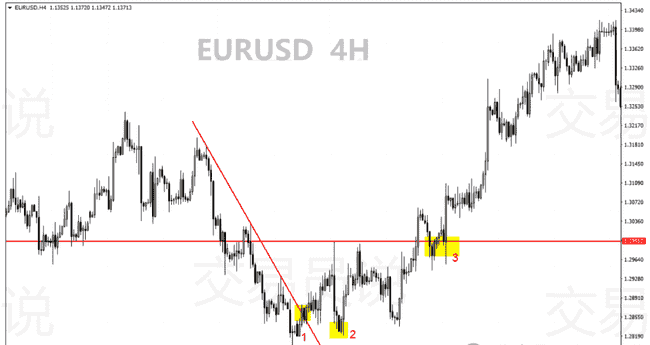
The 123 rule is highly flexible in practical use, reflected in the fact that its order can be scrambled (orders such as 213, 321, etc. are possible, but the third step must be completed) and it does not require all three steps to be completed (the second step can be absent, i.e., V-shaped reversals).
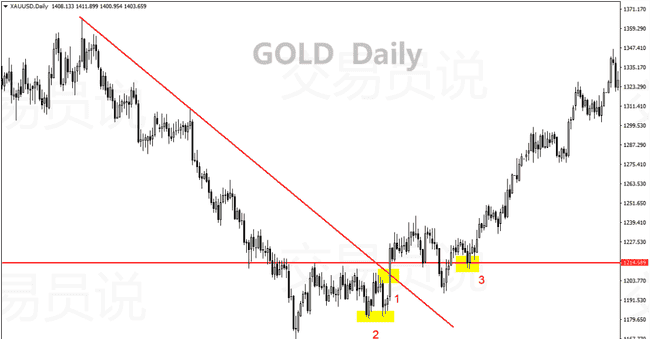
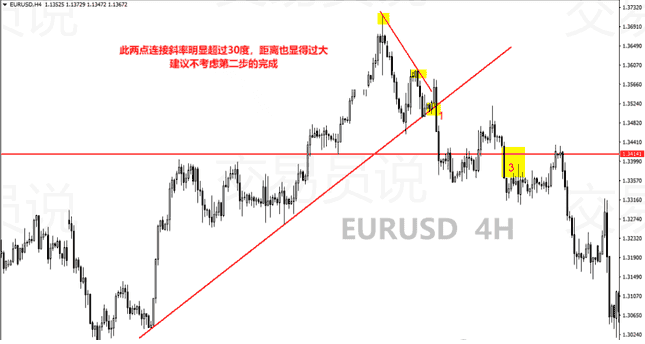
From the demonstration in the above charts, the use of the 123 rule is very simple, but there are still some difficulties, which will be explained step by step below.
The first point concerns probing the previous high or low in the second step. Often, the market does not provide a probe to the previous high or low but forms lower highs (LH) or higher lows (HL), as shown in the above Figures 1 and 2. This is not a problem, but how far apart can the previous high and the high point formed after probing still be considered as satisfying the 123 rule? Or how far can the low point formed after probing be from the previous low without being considered as completing the second step?
We tried to search for answers but found no satisfactory explanation. Therefore, our answer is that the line connecting the previous lows and the line formed after probing for low points should ideally have a slope not exceeding 30 degrees; conversely, if this line's slope exceeds 30 degrees, it should be considered as the 123 rule where the second step is absent.
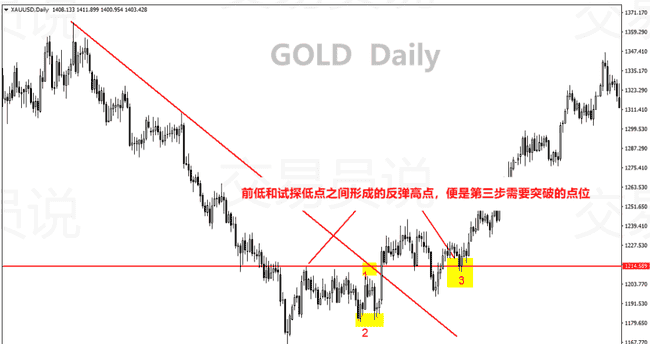
For this point, it is also important to note that the formation of low points should be based on turning points.
Of course, the aforementioned 30 degrees is not authoritative statistical data, just for reference; you may also measure according to your own understanding.
The second point is how to find the position that needs to be broken through in the third step. This requires consideration of different situations, namely whether the second step is completed or not.
First, let's consider the case where the second step has been completed. The position that needs to be identified is: in an uptrend, the low point formed between the previous high and the second-step probing high point.
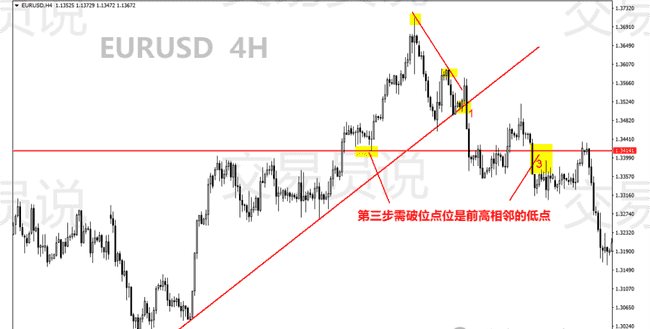
For the 123 rule that lacks a second step, the position to break through in the third step is: in an uptrend, the previous high and the low point closely adjacent to the previous high.
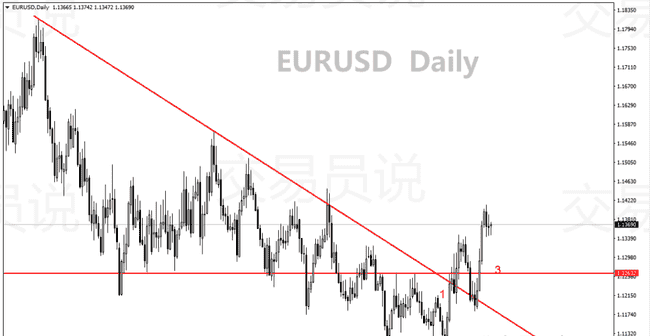
Did you notice? Whether the second step is completed will directly affect the confirmation of the third step.
In addition, as one of the methods for judging trend reversals, if the 123 rule coincides with a reversal pattern formed by a series of K lines (i.e., forming a reversal pattern while also satisfying the 123 rule), how should one handle it? We suggest that in such cases, follow the reversal pattern, as it may indicate the potential distance the market could run, while the 123 rule is ineffective in this regard.
To conclude, the 123 rule is not a foolproof method for judging trend reversals. In fact, it is not uncommon for the original trend to extend again after satisfying the 123 rule. Therefore, it is reasonable to determine short-term reverse market movements after completing the 123 rule, but confirming a major trend reversal may require more information.
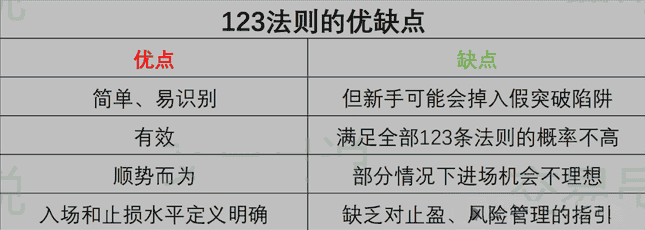
The 123 rule is essentially a rule for judging trend changes, which involves buying on dips in an uptrend and selling on rallies in a downtrend. The 123 rule is universal and is therefore widely used across major markets such as stocks and futures.
However, although the 123 rule is a simple and effective buy/sell strategy, there are a series of problems in practice. Therefore, investors are advised to follow the trend and test lightly when any two rules are satisfied, while effective risk management remains key.
◐ '2B rule combined with the 123 rule' trading strategy
As mentioned above, we can use the '123 rule' to judge trend reversals, but in this regard, the rule has extended to the '2B rule'. The 2B rule is a special form of the 123 rule that can not only assist in judging trend reversals but also provide earlier hints about potential entry points.
The 123 rule is a simple and practical way to judge short-term trend reversals. It is not limited by cycles or varieties, but its downside is also obvious: it signals entry points quite late, which is unacceptable for impatient traders. In terms of entry points, it indeed extends to new content, which is the 2B rule.
What is the 2B rule?
The 2B rule refers to two price breakouts: in an uptrend, if the price breaks the previous high (the first breakout) but fails to sustain the upward momentum and quickly drops back below the previous high (the second breakout), it suggests that this wave of upward movement may have changed.
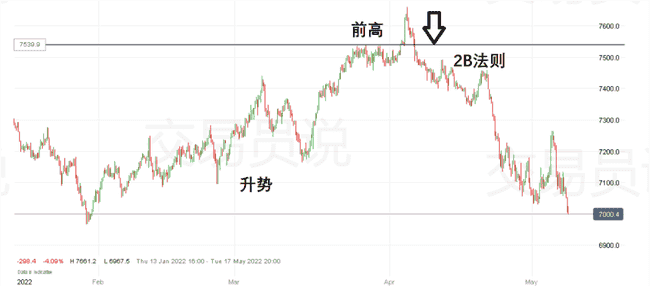
Similarly, in a downtrend, if the price briefly breaks below the previous low but quickly rebounds from the new low and breaks above the previous low, this downtrend may have changed.

In other words, the 'B' in the 2B rule stands for the English word Breakout. The first 'B' occurs when the price breaks above the previous high/low, but it ultimately proves to be a false breakout, as the price quickly falls back from the new high/low and further breaks through the previous high/low, forming the second 'B'.
The 2B rule is a special form of the 123 rule, which can not only assist in judging trend reversals but also provide earlier signals for entry points. Simply put, if the market probes the previous high (or low) and then quickly retreats, one can look for entry opportunities.
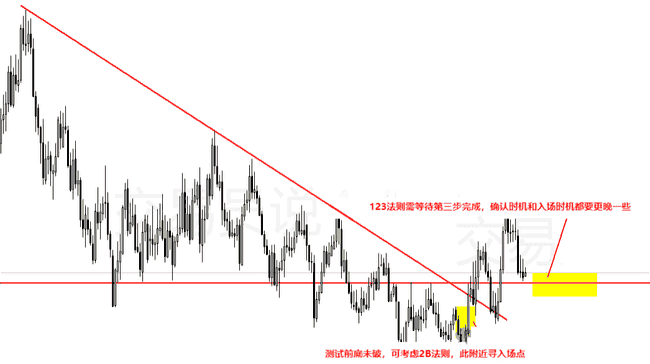
The 2B rule can be considered a blessing for the impatient, but the accompanying risks are also evident.
Upon closer inspection, the 2B rule indicates that after probing the previous high (or low), if the trend cannot continue promptly, it assesses a trend reversal and prepares for entry, which does not rule out the possibility of the market undergoing range consolidation. This means that based on this, the accuracy of predicting subsequent trend reversals is not high, and caution should be exercised regarding profit margins. For safety, it may be advisable to treat the 2B rule as a warning signal.
Moreover, after the emergence of the 2B rule, the 123 rule may still continue to be completed. The emergence of the 2B rule requires conditions; it must involve probing the previous high (or low) (not a confirmed breakout), and a V-shaped reversal cannot produce a 2B rule.
For the 123 rule and the 2B rule, we also need to consider the conditions that indicate they are no longer valid and adjust our actual operations in time.
Two conditions that invalidate the 123 rule:
1) The market has not confirmed a new trend and has returned above (or below) the previously broken trend line;
2) Has not returned above (or below) the trend line, but has broken through the previous high (or low).
Since the 2B rule does not require the cooperation of trend lines, the only condition for its failure is the confirmation of breaking the previous high (or low).

The chart above shows that although the price movement initially satisfied the conditions for the 2B rule and the 123 rule, the subsequent breakout of the previous high completely invalidated both.
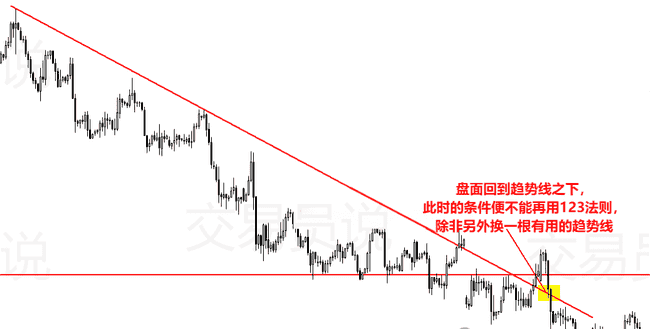
The chart above shows that when the market price returns below the trend line, the conditions no longer allow for the use of the 123 rule unless another useful trend line is drawn.
◐ 2B rule combined with the 123 rule trading method
The 2B rule is sufficient as a buy/sell signal; when the signal appears, go with the trend, and set the stop-loss at the level near the previous low or high. However, the market is ever-changing, and trend reversals often do not happen overnight but occur after continuous attempts. Therefore, trading using the 2B rule can easily lead to being stopped out. Hence, it is advisable for investors to start with light positions and set stop-losses as a priority.
So, how can we improve the success rate of the 2B rule trading method? You can trade using the following methods:
1) Combine with the 123 rule. After satisfying the 2B rule, enter the market with a light position and then use the 123 rule to increase the position when the opportunity arises.
2) Combine with the RSI indicator. For short-term traders, daily charts, 4-hour charts, or even minute-by-minute charts frequently show RSI overbought/oversold conditions, at which point trading the 2B rule has a high win rate.
3) Combine with trading volume. Before a trend reversal, from the perspective of K lines, the price often records a very obvious big bullish or bearish line. If this is accompanied by a significant increase in trading volume, the possibility of a 2B pattern will greatly increase.
Of course, there are many ways to enhance the 2B rule trading method. Investors can also combine the Elliott Wave Theory or other indicators that signal reversals for analysis. In any case, remember that effective risk management is key to trading.
◐ 2B rule and 123 rule summary
In summary, the 2B rule is a simple and effective way to judge trend reversals. However, new trends do not materialize overnight, so the core of the 2B rule trading is to always set stop-losses. Practice makes perfect; only through continuous training and summarization can one develop a trading system that suits them.
In fact, whether in the application of the 123 rule or the 2B rule or in considering invalid conditions, the essence is still to use the principle of judging trends based on the movement of high and low points.
High points no longer rise or low points no longer fall; this is the 2B rule.
High points no longer rise, and low points are likely to fall, or low points no longer fall, and high points are likely to rise; this is the 123 rule.
If these conditions are not met, it is when these two rules become invalid.


